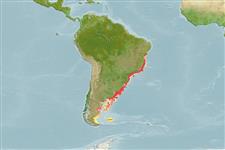Common names from other countries
>
Pleuronectiformes (Flatfishes) >
Paralichthyidae (Large-tooth flounders)
Etymology: Paralichthys: Greek, para = the side of + Greek, ichthys = fish + Greek, suffix, oides = similar to (Ref. 45335).
Environment: milieu / climate zone / depth range / distribution range
Ecologia
marino; salmastro demersale; distribuzione batimetrica 0 - 40 m (Ref. 26375). Subtropical; 12°S - 54°S
Southwest Atlantic: Brazil. Does not occur in Argentina nor in Uruguay (Ref. 43588).
Size / Peso / Age
Maturity: Lm ? range ? - ? cm
Max length : 100.0 cm TL maschio/sesso non determinato; (Ref. 26375); common length : 40.0 cm TL maschio/sesso non determinato; (Ref. 6077); peso massimo pubblicato: 12.0 kg (Ref. 26375)
Spine dorsali (totale) : 0; Raggi dorsali molli (totale) : 68 - 86; Spine anali: 0; Raggi anali molli: 52 - 67. Pectoral fins small, about two times head on ocular side, 2.7-3.0 time head on blind side. Pelvic fins about equal in size and shape on both sides. Caudal fin double truncate (Ref. 27363).
Inhabits coastal areas, in bays and estuaries (Ref. 36453). Found over sandy or muddy substrate. Apparently, reproduction occurs during summer in small groups of 3-15 individuals. Adults are solitary. This species is very much appreciated for its taste and high commercial value.
Life cycle and mating behavior
Maturities | Riproduzione | Spawnings | Egg(s) | Fecundities | Larve
Distinct pairing (Ref. 205).
Cervigón, F. and W. Fischer, 1979. INFOPESCA. Catálogo de especies marinas de interes economico actual o potencial para América Latina. Parte 1. Atlántico centro y suroccidental. FAO/UNDP, SIC/79/1. 372 p. FAO, Rome. (Ref. 6077)
IUCN Red List Status (Ref. 130435)
CITES (Ref. 128078)
Not Evaluated
Threat to humans
Harmless
Human uses
Pesca: commerciale; Pesce da pesca sportiva: si
Strumenti
Special reports
Download XML
Fonti Internet
Estimates based on models
Preferred temperature (Ref.
115969): 11.7 - 26.1, mean 16.1 (based on 150 cells).
Phylogenetic diversity index (Ref.
82804): PD
50 = 0.5000 [Uniqueness, from 0.5 = low to 2.0 = high].
Bayesian length-weight: a=0.00646 (0.00384 - 0.01085), b=3.16 (3.02 - 3.30), in cm Total Length, based on LWR estimates for this species & Genus-body shape (Ref.
93245).
Trophic level (Ref.
69278): 4.4 ±0.6 se; based on size and trophs of closest relatives
Resilienza (Ref.
120179): Medio, tempo minimo di raddoppiamento della popolazione 1.4 - 4.4 anni (Preliminary K or Fecundity.).
Fishing Vulnerability (Ref.
59153): High vulnerability (60 of 100).
